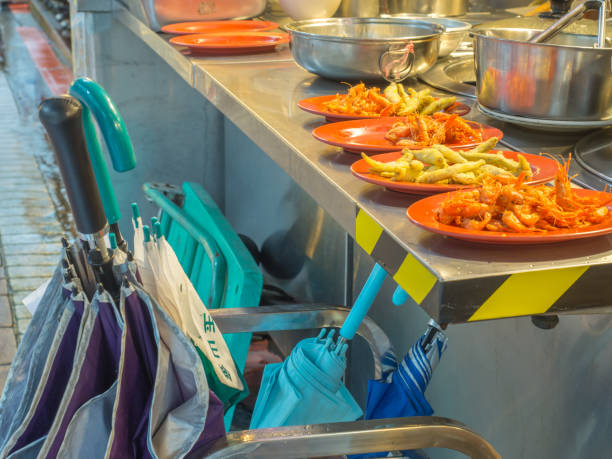chinatown hawker leftovers consumption Let’s paint a picture: the aroma of sizzling char chinatown hawker leftovers consumption kway teow fills the air, aunties call out orders like seasoned auctioneers, and plates of laksa and Hainanese chicken rice vanish into eager hands. You’re in the beating heart of one of the world’s most beloved food paradises—Chinatown, Singapore.
But beneath this colorful hustle lies a shadow that many don’t talk about: chinatown hawker leftovers consumption.
Now, before you go “Ew!” and scroll away—hold up. This isn’t just about scavenging scraps. Nope, it’s way more layered than that. We’re diving deep into the curious phenomenon that blurs the line between survival, sustainability, and cultural taboo. So grab a tissue (and maybe a snack), because this is going to be equal parts mouthwatering and thought-provoking.
The Hawker Heritage: A Culinary Wonderland
A Bite-Sized History
Hawker centers are the crown jewel of Singaporean street food—imagine open-air canteens packed with stalls serving dishes that have stood the test of generations. In Chinatown, the hawker culture is especially vibrant, a crossroads of Chinese heritage, culinary ingenuity, and economic hustle.
Back in the post-war years, hawkers set up stalls to earn a living with recipes passed down from their ancestors. As time marched on, the government formalized these operations, transforming alleyway setups into organized centers filled with regulated vendors.
But with great popularity comes great…wastage?
The Leftovers Nobody Talks About
What Exactly Is Chinatown Hawker Leftovers Consumption?
It’s not some TikTok trend or a new-age diet—chinatown hawker leftovers consumption refers to the practice of collecting and eating leftover food discarded or left behind at hawker centers, particularly in places like Singapore’s Chinatown.
Let’s clarify what this isn’t:
-
It’s not dumpster diving in the Western sense.
-
It’s not organized food rescue or charity distribution.
-
And it’s definitely not mainstream.
Instead, it’s often an unspoken, sometimes desperate behavior that sits somewhere between necessity and habit, occasionally dressed up in the language of sustainability.
Who’s Eating the Leftovers?
The Faces Behind the Phenomenon
Here’s the uncomfortable truth: many of those consuming hawker leftovers are elderly citizens, cardboard collectors, or the economically marginalized. These individuals aren’t seeking trendy waste-free living. They’re simply trying to survive.
Meet Uncle Lim, for example. Seventy-three, wiry frame, always clutching a plastic bag and a worn-out container. He doesn’t beg. He simply waits. When customers leave, he swoops in and checks the trays for untouched food.
It’s heartbreaking, yes—but it’s also eye-opening. This quiet practice has become part of the Chinatown ecosystem, something many pretend not to see.
Why Does This Happen in a “First-World” City?
Singapore is wealthy, clean, and efficient. So why does chinatown hawker leftovers consumption still exist?
Let’s unpack it.
1. Poverty Hides in Plain Sight
While Singapore has a robust economy, its social safety net doesn’t always catch everyone. Not every elderly person has CPF savings or family to care for them.
2. The Price of Progress
Gentrification, rising costs, and an obsession with “efficiency” have squeezed out informal community support systems.
3. Stigma of Asking for Help
In Asian cultures, pride runs deep. Many would rather eat leftovers than admit they need charity.
Leftovers or Lifelines? The Moral Gray Area
There’s no sugarcoating it—it’s controversial.
Some people say:
-
“It’s unsanitary and undignified.”
-
“It’s not safe!”
-
“Authorities should stop it!”
Others argue:
-
“Food shouldn’t be wasted.”
-
“If it helps someone live another day, who are we to judge?”
-
“Maybe this is more about us not wanting to see poverty.”
And here’s the kicker: the hawker center cleaning crews see it every day, and often turn a blind eye.
Sustainability vs. Survival
In a world that’s pushing for sustainable living and zero waste, how do we reconcile this gritty reality?
Isn’t It Better Than Throwing It All Away?
Each day, hawker centers dispose of hundreds of kilograms of perfectly edible food. Meanwhile, we’ve got citizens scavenging for scraps. Irony, much?
Some sustainability advocates have even floated the idea of structured leftover-sharing apps or “community fridges” near hawker centers—but these often get buried in red tape or public resistance.
Turning Scraps Into Solutions
What Can Be Done?
Here are some practical ideas that don’t involve looking the other way:
-
Community Food Banks – On-site fridges or tables where people can leave untouched leftovers or donate extra portions.
-
Hawker Stall Partnerships – Stalls offering end-of-day discounts or meals to registered individuals in need.
-
Policy-Level Reform – Streamlining food redistribution laws so hawkers aren’t liable when donating unsold meals.
-
Awareness Campaigns – Changing the conversation from shame to support.
Frequently Asked Questions (FAQs)
Q1: Is it legal to eat leftovers in Chinatown hawker centers?
There’s no law explicitly prohibiting it, but most establishments have hygiene regulations that discourage it.
Q2: Is the food safe?
Depends. While much of it is untouched, it can be risky due to exposure and temperature changes.
Q3: Are there any charities involved in helping these individuals?
Yes, but outreach doesn’t always reach everyone, especially those too proud or too hidden to ask for help.
Q4: Could technology solve the problem?
Absolutely. Apps and networks could streamline food donation, but public and governmental support is needed.
Q5: Why not just give them money or free food?
Some do—but not everyone in need wants to be seen taking handouts. Leftovers are often the “invisible” solution.
The Cultural Lens: Shame, Pride & The Asian Way
It’s easy to pass judgment from afar, but chinatown hawker leftovers consumption lives in a cultural context. In many Asian societies, especially among older generations, asking for help carries stigma.
There’s also a generational divide: while young Singaporeans champion sustainability, older folks are just trying to eat without burdening anyone. One person’s “waste not, want not” is another’s survival strategy.
The Unseen Dialogue Between Trays and Tables
Next time you’re at a Chinatown hawker center, slow down. Look around. That tray you’re clearing? Someone may be eyeing it—not with disdain, but with quiet hope.
Is it sad? Yes.
Is it solvable? Also yes.
But only if we’re willing to see it. Talk about it. And, most importantly, act on it.
Conclusion: From Silence to Solutions
“Waste nothing” is more than an old saying—it’s a reality for many in Chinatown. Chinatown hawker leftovers consumption isn’t just about food. It’s about systems, stigma, sustainability, and seeing people we often ignore.
Maybe, just maybe, if we stop averting our eyes and start opening our hearts, that leftover piece of char siu could mean more than just a missed meal—it could become the seed of change.
So, the next time you’re polishing off your nasi lemak at a hawker stall, ask yourself: Am I truly done with this meal? Because someone else might just be starting theirs.







